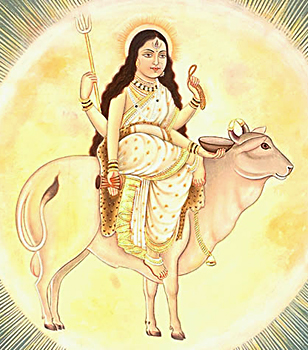 The standing image of four-armed Gauri-Parvati is very common in eastern India especially in Bengal. There are six varieties of Gauri includes Uma, Parvati, Sri, Rambha, Totala and Tripura. The images of Gauri-Parvati are associated with Godha. A lot of images of Gauri-Parvati have been found mostly in the eastern parts of India.
The standing image of four-armed Gauri-Parvati is very common in eastern India especially in Bengal. There are six varieties of Gauri includes Uma, Parvati, Sri, Rambha, Totala and Tripura. The images of Gauri-Parvati are associated with Godha. A lot of images of Gauri-Parvati have been found mostly in the eastern parts of India.
The images are generally are very well executed and are of immense artistic merit. The four-armed goddess stands in the samapadasthanaka pose having the attributes like lingam with rosary in the upper right, a tridandi or trident in the upper left. She bears a boon or pomegranate in the lower right and vase in the lower left hand. The goddess is represented wearing a jatamukuta and other ornaments on her body. She also wears a sacred thread. There is a halo around her head and the usual flying viyadhara figures on either side of the Krittimukha shown on the top of the decorated elliptical prabhavati.
The iconography suggests that usually the image of the goddess is attended by two female attendants one each standing on either side of the goddess with a fly-whisk in their respective right hands. There is a pair of plantain trees near each of the female attendants and the figure of a lion and an antelope are shown on the right and left sides of the goddess respectively. The lion and antelope are represented seating beneath plantain trees.
Heaped naivedya pots are placed on either corner of the lower section of the pedestal, when the figure of the creeping iguana is also shown in a separate compartment beneath the lotus pedestal of the goddess.
Another iconography of goddess Gauri is represented as an unmarried girl either with two hands in the abhaya or the varada poses or with four hands three of which bears akshamala, padma and kamandulu; while the fourth hand is in the abhaya pose.
Goddess Gauri is worshipped in various aspects. She is also worshipped also as goddess Uma. In the form of Uma, the iconography suggests that her hands bear an akshamala a mirror, a lotus and a kamandulu. When Gauri is worshipped as Parvati the deity is represented as having four arms. All the four arms of the goddess bear an akshmala, an image of Lord Shiva, an image of Lord Ganesha and a kamandulu. The abode of the goddess is between the agni-kundas.
Another iconographical image of the goddess Gauri represents her as a female figure standing upon the back of an alligator. This particular image of Gauri is generally worshipped in household by them who desire wealth and prosperity. The deity is shown as having four hands. In two of her hands she bears the akshasutra and the padma; while the other two are kept in varada and abhaya pose respectively.
Rambha is another form of worshipping the goddess Gauri. It is believed that the goddess in the form of Rambha fulfills all the desires of her devotees. She is shown as seating on an elephant. The goddess is in a handsome form and has four arms. In her hands she bears kamandulu, akshamala, vajra and ankusa.
Totala is another aspect of goddess Gauri who bears the sula, akshamala, danda and a white chauri. This particular goddess is said to destroy all sins. Tripura another form of Gauri has four arms. In two of her hands she bears an ankusa and a pasa while the other two are held in a varada and an abhaya pose.
The iconographical records suggest that in a temple dedicated to Gauri; Gauri is the central figure of the temple. Towards the left of the central image is the figure of Siddhi and towards the right stands the image of Sri. There are also the images of Bhagavati and Saraswati in the pristhakarna bhaga. Lord Ganesha is in the north-east corner and Kumara or Lord Kartikeya in the south-east corner of the temple. There are generally eight door keepers in the temple of Gauri and one of the hands of the doorkeeper bears a danda while the other is in the pose of an abhaya. The gatekeepers of the temple Jaya and Vijaya bear an ankusa and a pasa, Ajita and Aparajita has a padma and a pasa, Vibhakta and Mangala has a vajra and an ankusa and Mohini and Stambhini bears a Sankha and a padma.
Iconography of Gauri-Parvati is, thus, widely varied all over the country as the goddess is worshipped in six different forms.




